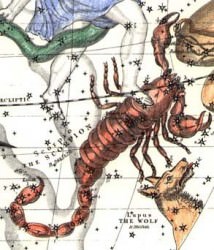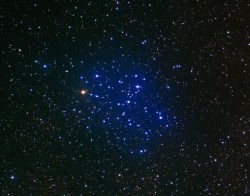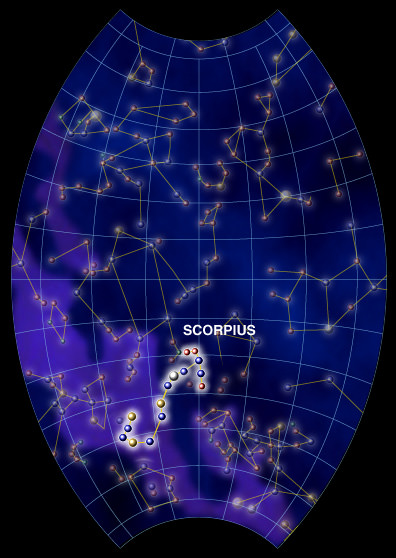Howdy, kids! Over the last couple of months we’ve visited with a multitude of wonderful sky characters. We’ve located the Triangle, met the Dragon, visited in the Royal House, met a King and Queen and their children, a celestial Herdsman and his grandchildren, and we’ve even met an ancient Egytian! Now when we go out at night, we often find ourselves surrounded by bugs and other creepy crawlies in the night. Did you know that you can find them in the stars, too? Then sit back and listen to the voices on the wind as it tells you where to look…
 “One of the easiest of the summer creepy crawlers to find is the constellation of Scorpio high in the south after the Sun sets. You’ll recognize it easily by its many bright stars and long, graceful J-shape. If you’re not sure, look for the giant red star – Antares – whose name means the “Rival of Mars”. If you have good eyes or binoculars, look for the beautiful optical double star where Scorpio’s tail starts. That’s Omega, whose blue and gold colors stand out against the night. At the southern tip of the J is another beautiful double star – Shaula – whose name “the Stinger” is well earned!”
“One of the easiest of the summer creepy crawlers to find is the constellation of Scorpio high in the south after the Sun sets. You’ll recognize it easily by its many bright stars and long, graceful J-shape. If you’re not sure, look for the giant red star – Antares – whose name means the “Rival of Mars”. If you have good eyes or binoculars, look for the beautiful optical double star where Scorpio’s tail starts. That’s Omega, whose blue and gold colors stand out against the night. At the southern tip of the J is another beautiful double star – Shaula – whose name “the Stinger” is well earned!”
 Are you ready to go hunting for a blue moth? Then aim your binoculars about a fistwidth north of the “Stinger” and behold the “Butterfly”! It’s proper name is Messier Object 6, but on a warm and hazy night, it appears like a beautiful blue moth in binoculars. Do you see another hazy spot nearby to the south? This pretty open star cluster is Messier Object 7 and is often called “Ptolemy’s Cluster” but looks like a swarm of bright fireflies! Are you ready for more? Then take a closer look at Antares for the ants… In even small binoculars you will see a fine, powdery ball of stars that looks like tiny ants gathering near a red drop of Popsicle! These stars belong to Messier Object 4 – a globular cluster.”
Are you ready to go hunting for a blue moth? Then aim your binoculars about a fistwidth north of the “Stinger” and behold the “Butterfly”! It’s proper name is Messier Object 6, but on a warm and hazy night, it appears like a beautiful blue moth in binoculars. Do you see another hazy spot nearby to the south? This pretty open star cluster is Messier Object 7 and is often called “Ptolemy’s Cluster” but looks like a swarm of bright fireflies! Are you ready for more? Then take a closer look at Antares for the ants… In even small binoculars you will see a fine, powdery ball of stars that looks like tiny ants gathering near a red drop of Popsicle! These stars belong to Messier Object 4 – a globular cluster.”
“If you stop to admire the constellation of Scorpius on a dark night, perhaps you’ll notice a silvery band that seems to curve down the sky towards its bright stars. That’s no cloud… That’s the Milky Way! The stars of Scorpius help to point the way to our own galaxy’s spiral arm. Doesn’t it look like a silver road? There is a legend that the sky god Helios allowed his son Phaeton to drive his Sun chariot along this road. When he encountered the Scorpion, he wrecked an caused an awful fire that made the deserts in Africa and caused the people’s skin to turn black.”
The Moon is now waxing and moving gradually east each night. It won’t be long until it passes through Scorpius and near Antares on a very special date – July 4th! For some lucky kids somewhere, this could mean an occultation event… a time when the Moon will “cover up” the bright red star as they pass each other in the night. For others, the pair will only be close, but what a treat to point out your new “star smarts” to others while you’re out watching fireworks!


